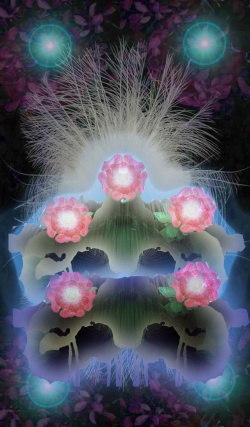Difference between revisions of "Red"
| Line 1: | Line 1: | ||
| − | <nomobile>{{DisplayImages|766|4494|1305|4137|4545|2490|1737|403 | + | <nomobile>{{DisplayImages|766|4494|1305|4137|4545|2490|1737|403}}</nomobile> |
Latest revision as of 10:07, 8 February 2017
Red is any of a number of similar colors evoked by light consisting predominantly of the longest wavelengths of light discernible by the human eye, in the wavelength range of roughly 625-740 nm. Longer wavelengths than this are called infrared, or below red and cannot be seen by the naked human eye. Red is used as one of the additive primary colors of light, complementary to cyan, in RGB color systems. Red is also one of the subtractive primary colors of RYB color space but not CMYK color space.
In human color psychology, red is associated with heat, energy and blood, and emotions that "stir the blood", including anger, passion, and love.
Red is any of a number of similar colors evoked by light consisting predominantly of the longest wavelengths of light discernible by the human eye, in the wavelength range of roughly 630-700 nm. Longer wavelengths than this are called infrared, or below red and cannot be seen by human eyes.
Red's wavelength has been an important factor in laser technologies as red lasers, used in early compact disc technologies, are being replaced by blue lasers, as red's longer wavelength causes the laser's recordings to take up more space on the disc than blue lasers.[10] Red light is also used to preserve night vision in low-light or night-time situations, as the rod cells in the human eye aren't sensitive to red. Red is used as one of the additive primary colors of light, complementary to cyan, in RGB color systems. Red is also one of the subtractive primary colors of RYB color space but not CMYK color space.
One common use of red as an additive primary color is in the RGB color model. Because "red" is not by itself standardized, color mixtures based on red are not exact specifications of color either. In order to produce exact colors the color red needs to be defined in terms of an absolute color space such as sRGB. As used in computer monitors and television screens, red is very variable, but some systems may apply color correction (so that a standardized "red" is produced that is not in fact full intensity of only the red colorant).
A red filter used in black and white photography increases contrast in most scenes. For example, combined with a polarizer, it can turn the sky black. Films simulating the effects of infrared film (such as Ilford's SFX 200) do so by being much more sensitive to red than to other colors. Red illumination was (and sometimes still is) used as a "safelight" while working in a darkroom, as it does not expose most photographic paper and some films. Though many more modern darkrooms use an amber safelight, red illumination is closely associated with the darkroom in the public mind.
Etymology and Definitions
The word red comes from the Old English read. Further back, the word can be traced to the Proto-Germanic rauthaz and the Proto-Indo European root reudh-.
This is the only color word which has been traced to an Indo-European root.
In Sanskrit, the word rudra means red. In the English language, the word red is associated with the color of blood, certain flowers (i.e. roses), and ripe fruits (i.e. apples, cherries). Fire is also strongly connected, as is the sun and the sky at sunset.
Healthy people are often said to have a redness to their skin color (as opposed to be appearing pale). After the rise of socialism in the mid-19th century, red was to describe revolutionary movements. The word is also obviously associated with anything of the color occupying the lower end of the visible light spectrum, such as red hair or red soil.
Red Indians is a British term for Native Americans, American terms for this ethnic group include redskin, redhead and red man, though they are not the preferred terms.
In Nature
In astronomy, stars of spectral type M (the stars with the coolest temperature) are classified as red stars.
Mars is called the Red Planet because of the reddish color imparted to its surface by the abundant iron oxide present there. Astronomical objects which are moving away from the observer exhibit a red shift.
Jupiter's surface displays a Great Red Spot, a football-shaped area south of the planet's equator. Astronomers believe the spot to be some kind of storm.
Oxygenated blood is red due to the presence of oxygenated hemoglobin.
Red light is the first to be absorbed by sea water, so that many fish and marine invertebrates that appear bright red are black in their native habitat.
When used about animal coloration red usually refers to a brownish, reddish-brown or ginger color. In this sense it is used to describe coat colors of reddish-brown cattle and dogs, and in the names of various animal species or breeds such as red fox, red squirrel, red deer, Robin Redbreast, Red Grouse, Red Knot, Redstart, Redwing, Red Setter, Red Devon cattle etc.
The usage for animal color appears similar to that for red ochre, red hair and Red Indian.
Red appears to be rarely used in names of animals which are a brighter blood-red or scarlet color (Carmine Bee-eater, Scarlet Tanager). When used for flowers, red often refers to purplish (red deadnettle, red clover, red helleborine) or pink (red campion, red valerian) colors.
Aggression, anger, blood, blushing, stop, Communism, courage, danger, guilt, energy, fire, hate, hell, honor, leadership, passion, socialism, sacrifice, sex, sin, violence, negativity, warning.
A biblical example is found in Isaiah: "Though your sins be as scarlet, they shall be white as snow." Also, The Scarlet Letter an 1850 American novel by Nathaniel Hawthorne, features a woman in a Puritan New England community who is punished for adultery with ostracism, her sin represented by a red letter 'A' sewn into her clothes. This all comes from a general Hebrew view inherited by Christianity which associates red with the blood of murder, as well as with guilt in general.
Another popular example of this is in the phrase "caught red-handed", meaning either caught in an act of crime or caught with the blood of murder still on one's hands. At one point, red was associated with prostitutes, or now, with brothels (red-light districts).
In Roman Catholicism, red represents wrath, one of the Seven Deadly Sins. In Christianity, Satan is usually depicted as colored red and/or wearing a red costume in both iconography and popular culture. Statistics have shown that red cars are more likely to be involved in accidents.
The color red is associated with lust, passion, love, and beauty as well. The association with love and beauty is possibly related to the use of red roses as a love symbol. Both the Greeks and the Hebrews considered red a symbol of love, as well as sacrifice. Psychological research has shown that men find women who are wearing red more attractive.
Red is also used as a symbol of courage and sacrifice, as in blood spilt in sacrifice or courage in the face of lethal danger. Examples of this are found in the flags of many nations including the United States, as well as in the novel The Red Badge of Courage, in which a soldier in the American Civil War discovers the meaning of courage.
Besides the association with guilt previously mentioned, in Christianity, red represents the color of Christian martyrs who suffered death for their faith. It is sometimes used for Holy Thursday and during Eastertide, and red green and white is the color scheme of Christmas. In Roman Catholic tradition it is used for all feast days of Christian martyrs as well as Palm Sunday in anticipation of the death of Jesus.
Along the same lines, red is associated in Roman mythology with the god of war, Mars. A Roman general receiving a triumph had his entire body painted red in honor of his achievement.The phrase "red-blooded" describes someone who is audacious, robust, or virile.
In English heraldry, red (called gules) denoted ardent affection or love, while crimson (blood-color) stood for boldness, enthusiasm, or impetuosity.
Warning
Red catches people's attention, and is often used either in a negative way to indicate danger and emergency, or in a positive way in advertising to gain more viewers, or in nature, as a ripe fruit announces its readiness with its red color. Several studies have indicated that red carries the strongest reaction of all the colors, with the level of reaction decreasing gradually with orange, yellow, and white, respectively. Because of this, scientists have repeatedly recommended red for warning signals, labels, and signs. Because of these recommendations, red has seen widespread use as a danger signal, in stop signs, to warn people of extreme heat or flammability, and even to signal warnings in sports such as soccer.
In Religion
Red may represent fire and so may symbolize the presence of God.
In Christianity, red is the liturgical color for Pentecost. Also, in the Catholic Church red is the color of a martyr.
In Islam red is the color for sacrificement and courage. Many Islamic states have it as a sign of the courage of Muslims and the sacrifice of their lives for what is good.
In Metaphysics
In metaphysics red connects with the root chakra.
Alice Bailey developed a system called the Seven Rays, where she classified humans into seven different metaphysical psychological types, the "sixth ray" of "love-devotion" is represented by the color red. People who have this metaphysical psychological type are said to be "on the Red Ray".
Psychics who claim to be able to observe the aura with their third eye report that a red aura is associated with a love of sports and physical exercise.
Red Crystals
In Non-Western Traditions
In China, red is the symbol of fire and the south (both south in general and Southern China specifically). It carries a largely positive connotation, being associated with courage, loyalty, honor, success, fortune, fertility, happiness, passion, and summer. In Chinese cultural traditions, red is associated with weddings (where brides traditionally wear red dresses) and red paper is also frequently used to wrap gifts of money or other things. Special red packets called hong bao as in Mandarin or lai see as in Cantonese - are specifically used during the Chinese New Year to give monetary gifts. On the more negative end, obituaries are traditionally written in red ink, and to write someone's name in red signals either cutting them out of your life, or that they have died. Red is also associated with both the feminine yin and the masculine yang, depending on the source. When someone commits suicide, especially a female, and wants to haunt their loved one, they will dress in red from top to bottom before carrying out the act.
In Japan, red is a traditional color for a heroic figure.
In the Indian Sub-continent, red is the traditional color of bridal dresses, and is frequently represented in the media as a symbolic color for married women. The color is associated with sexuality in marriage relationships through its connection to heat and fertility. It is also the color of wealth, beauty, and the goddess Lakshmi.
In Central Africa, Ndembu warriors rub themselves with red during celebrations. Since their culture sees the color as a symbol of life and health, sick people are also painted with it. Like most Central African cultures, the Ndembu see red as ambivalent, better than black, but not as good as white.[39] In other parts of Africa, however, red is a color of mourning, representing death. Because of the connection red bears with death in many parts of Africa, the Red Cross has changed its colors to green and white in parts of the continent.







